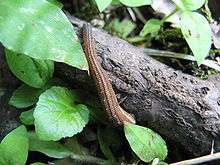Haemadipsidae
Haemadipsidae (From Greek "haima" and "dipsa" ("blood" and "thirst", respectively)) are a family of "jawed leeches". Some are classed as monophyletic group of hirudiniform proboscisless leeches. These leeches have five pairs of eyes, with the last two separated by two eyeless segments. Most have two jaws, but some have three. The family is monotypic, containing only the subfamily Haemadipsinae, though as the family can apparently be divided into two or three distinct lineages, at least one of the proposed splits, while not a distinct family, might be a valid subfamily.[1]
| Haemadipsidae | |
|---|---|
 | |
| Japanese mountain leech (Haemadipsa zeylanica) | |
| Scientific classification | |
| Kingdom: | Animalia |
| Phylum: | Annelida |
| Class: | Clitellata |
| Infraclass: | Euhirudinea |
| Order: | Arhynchobdellida |
| Suborder: | Hirudiniformes |
| Family: | Haemadipsidae Blanchard, 1893 |
| Genera | |
|
14, see text | |
| Synonyms | |
|
Domanibdellidae | |
Commonly known as jawed land leeches, these annelids are known from subtropical and tropical regions around the Indian and Pacific Ocean.[1] Well-known Haemadipsidae are for example the Indian Leech (Haemadipsa sylvestris) and the yamabiru or Japanese Mountain Leech (Haemadipsa zeylanica). Members of the family feed on blood, except Idiobdella which has adapted to eat small snails.[1]
The other notable group of jawed blood-sucking leeches are the aquatic Hirudinidae. The Xerobdellidae are sometimes included in the Haemadipsidae, but their status as a distinct family is supported by sequence analysis of the nuclear 18S and 28S rDNA and mitochondrial COI genes as well as the anatomy of their sexual organs and nephridia; the latter are located at the belly rather than along the body sides as in the Haemadipsidae proper. All Xerobdellidae have three jaws.[1]
Haemadipsidae probably originate in the Triassic, more than 150 million years ago (mya). The diversification of the large Asian genus Haemadipsa probably did not take place until the Eocene, about 50 mya.[1]
Because members of this family are terrestrial, feed on vertebrate blood, and digest blood meals fairly slowly,[2] they are used in invertebrate-derived environmental DNA (eDNA) research.[3] By extracting DNA from leech guts and sequencing vertebrate-specific genes, it is possible to identify which vertebrate the leech in question has fed upon, and therefore what animals are in the surrounding habitat.[4] This methodology can be complementary to camera trap biodiversity surveys, which often undercount smaller animals.
Selected genera
- Amicibdella
- Chtonobdella
- Haemadipsa
- Hygrobdella
- Idiobdella
- Malagabdella
- Nesophilaemon
- Philaemon
- Phytobdella
Footnotes
- Borda, Elizabeth; Oceguera-Figueroa, Alejandro; Siddall, Mark E. (January 2008). "On the classification, evolution and biogeography of terrestrial haemadipsoid leeches (Hirudinida: Arhynchobdellida: Hirudiniformes)". Molecular Phylogenetics and Evolution. 46 (1): 142–154. doi:10.1016/j.ympev.2007.09.006. PMID 17977750.
- Schnell, Ida Bærholm; Thomsen, Philip Francis; Wilkinson, Nicholas; Rasmussen, Morten; Jensen, Lars R.D.; Willerslev, Eske; Bertelsen, Mads F.; Gilbert, M. Thomas P. (April 2012). "Screening mammal biodiversity using DNA from leeches". Current Biology. 22 (8): R262–R263. doi:10.1016/j.cub.2012.02.058. PMID 22537625.
- Tessler, Michael; Weiskopf, Sarah R.; Berniker, Lily; Hersch, Rebecca; Mccarthy, Kyle P.; Yu, Douglas W.; Siddall, Mark E. (22 February 2018). "Bloodlines: mammals, leeches, and conservation in southern Asia". Systematics and Biodiversity. 16 (5): 488–496. doi:10.1080/14772000.2018.1433729.
- Siddall, Mark E.; Barkdull, Megan; Tessler, Michael; Brugler, Mercer R.; Borda, Elizabeth; Hekkala, Evon; Doi, Hideyuki (22 February 2019). "Ideating iDNA: Lessons and limitations from leeches in legacy collections". PLOS ONE. 14 (2): e0212226. Bibcode:2019PLoSO..1412226S. doi:10.1371/journal.pone.0212226. PMC 6386349. PMID 30794582.